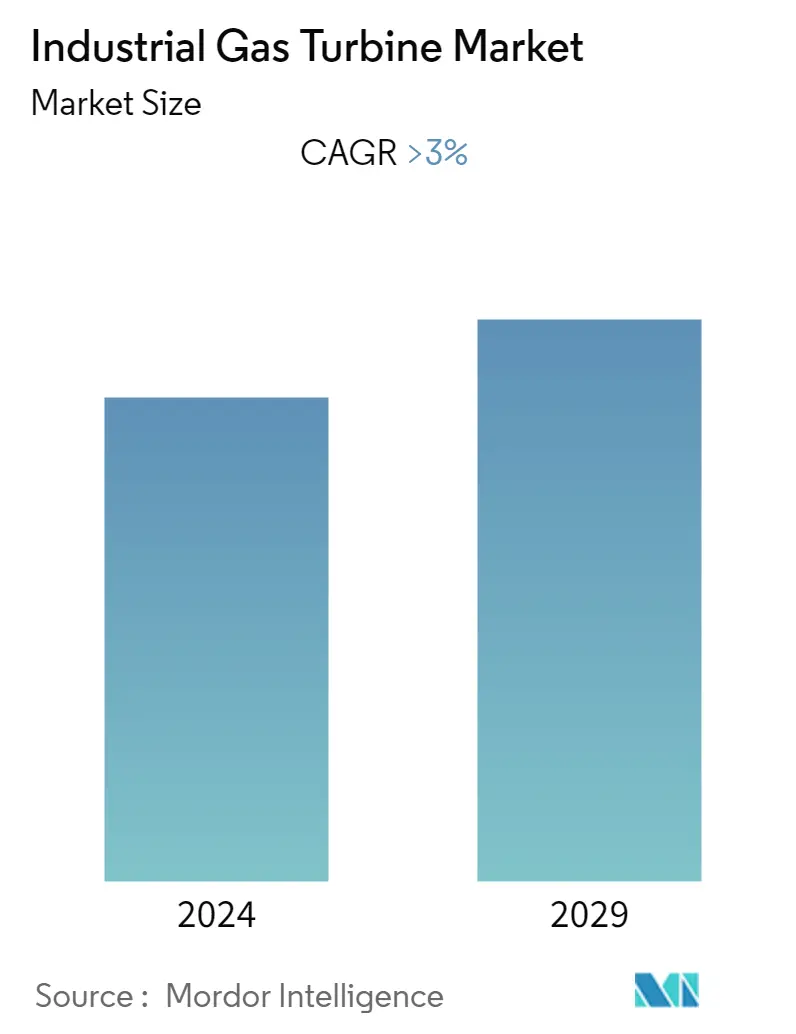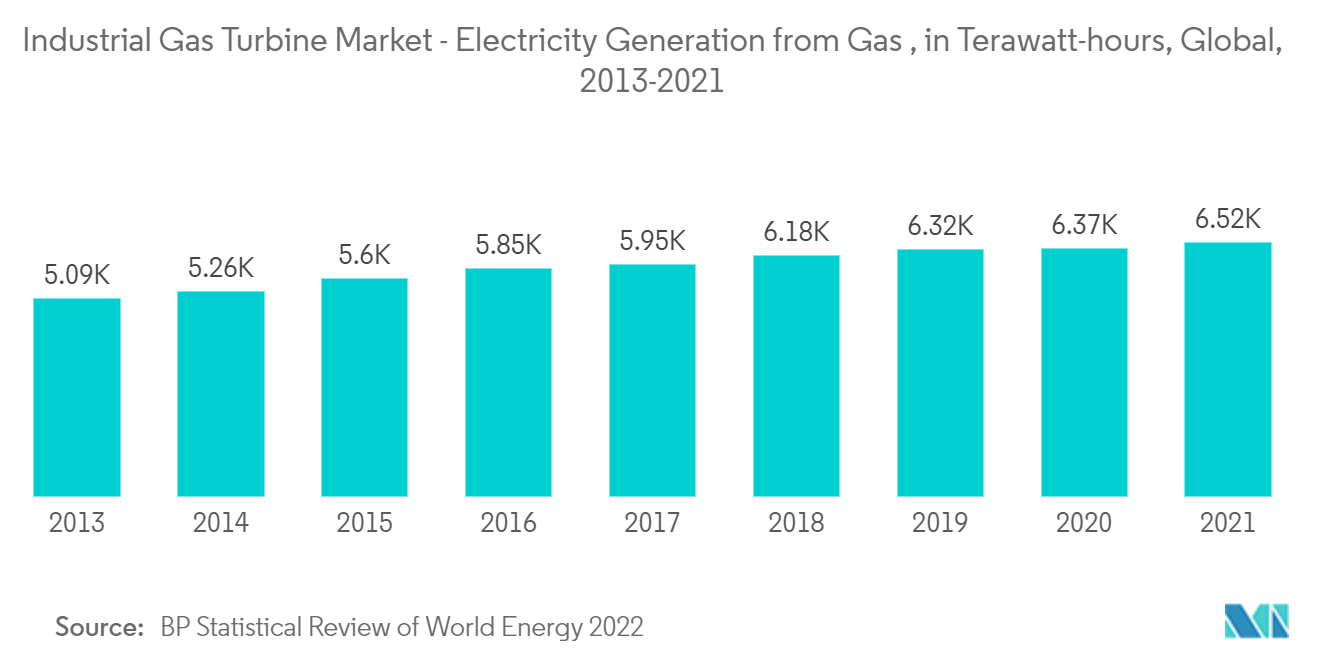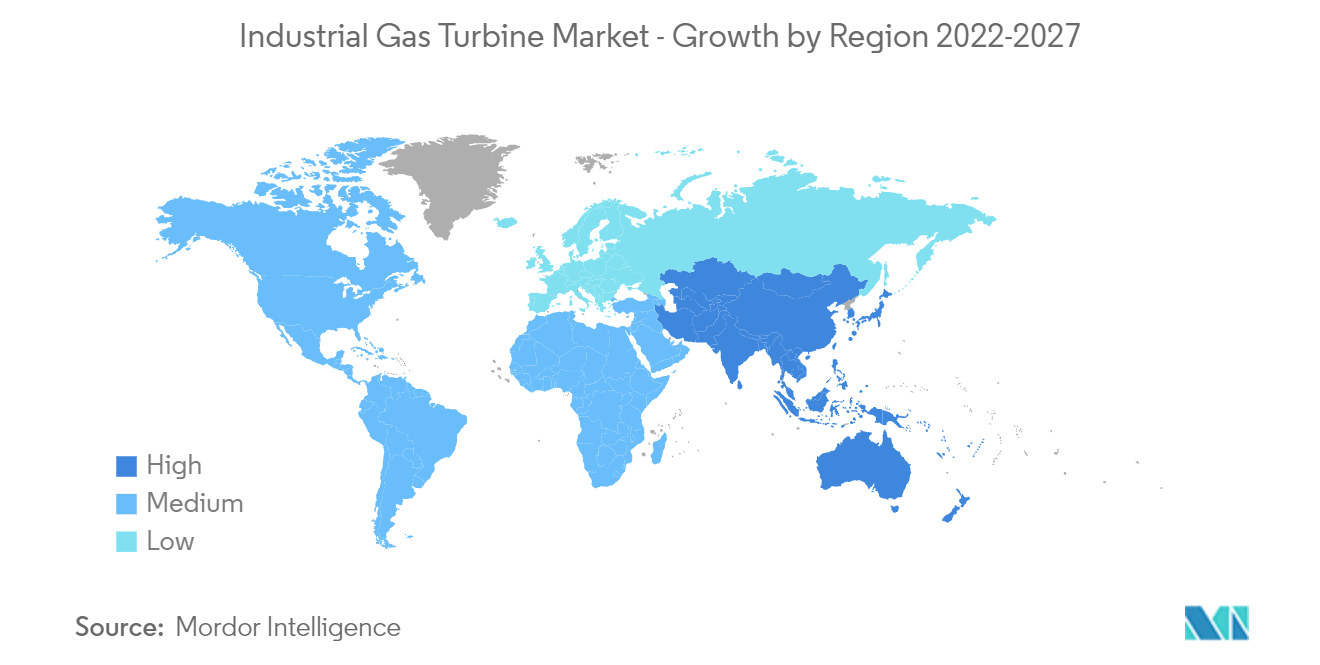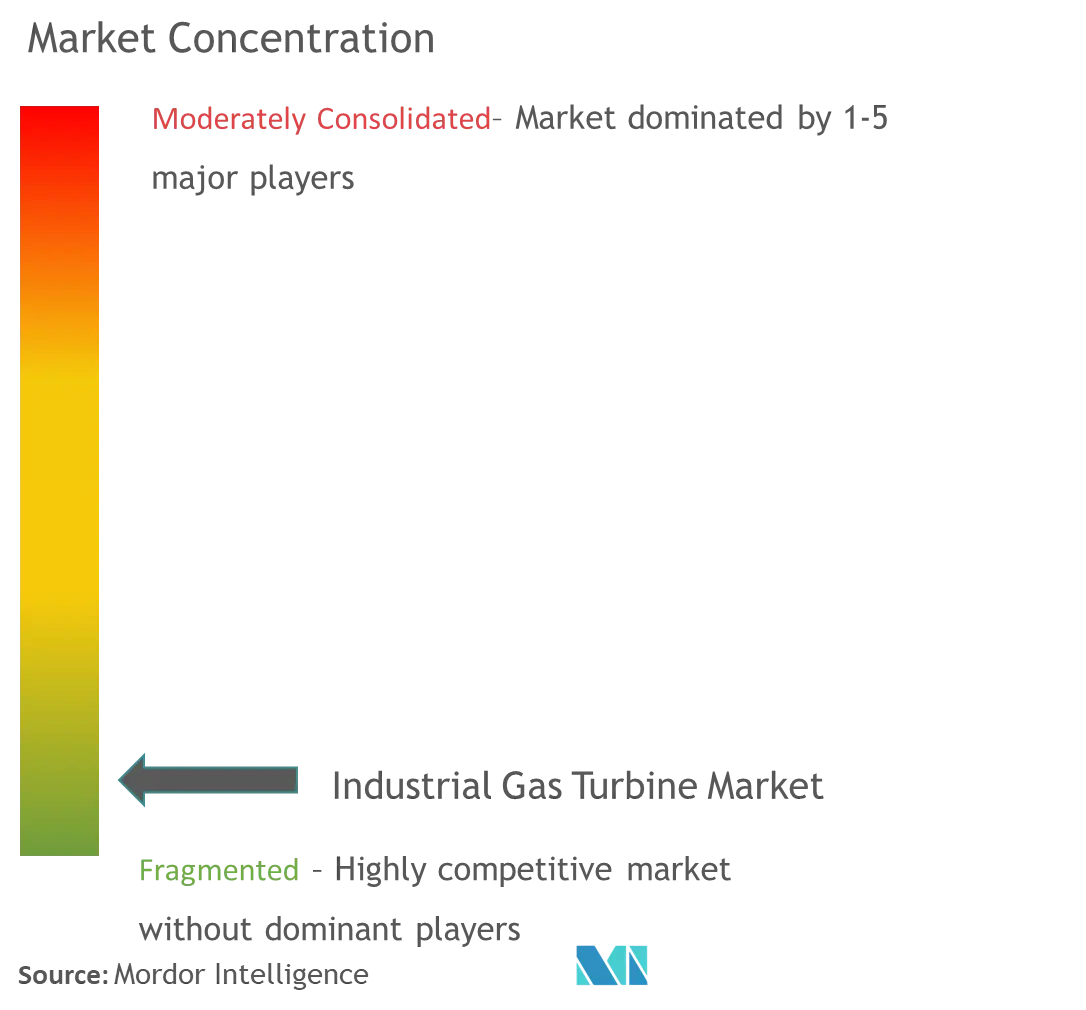Industrial Gas Turbine Market Size

| Study Period | 2021 - 2029 |
| Base Year For Estimation | 2023 |
| CAGR | 3.00 % |
| Fastest Growing Market | Asia Pacific |
| Largest Market | North America |
| Market Concentration | Low |
Major Players
*Disclaimer: Major Players sorted in no particular order |
Industrial Gas Turbine Market Analysis
The Industrial Gas Turbine Market is expected to register a CAGR of over 3% during the forecast period.
The market was negatively impacted by COVID-19 in 2020. Presently the market has now reached pre-pandemic levels.
- Over the medium term, factors such as rapid urbanization, increasing demand for electrical energy, and the rising demand for cleaner energy from gas turbines, over concerns about the environmental impact of energy generation from coal-fired plants, are likely to drive the industrial gas turbine market during the forecast period.
- On the other hand, the increasing shift toward renewable energies, such as solar and wind, for power generation has hampered the market's growth.
- Nevertheless, with the increasing demand for electrical energy to sustain global development, there is a need for consistent heavy investments in power supply generation. This has helped the market for gas turbines grow significantly in recent years, and it is expected to continue to do so during the forecast period. This, in turn, is likely to create opportunities for the market in the near future.
- Asia-Pacific is expected to dominate the market growth, with the majority of demand coming from China and India, owing to factors like economic growth in emerging nations, an increase in the number of gas-based power generation plants, and rising industrial activities.
Industrial Gas Turbine Market Trends
This section covers the major market trends shaping the Industrial Gas Turbine Market according to our research experts:
Power Sector to Dominate the Market
- The increased natural gas production has shifted the global focus on developing gas-fired power plants. Compared to coal-fired power plants, the emissions of greenhouse gases from gas-fired power plants are relatively lower. Additionally, gas-based power generation could be the most efficient way to meet the rising worldwide need for peak power.
- Gas turbine power generation is more efficient than conventional power generation, giving this technology an advantage over them. In 2021, power generated from natural gas accounted for 22.8% of all electricity generated globally, while electricity generated from coal has steadily decreased in share.
- In 2021, global electricity consumption upsurged more than primary energy consumption, with increases at 6.2% and 5.8%, respectively. The electricity demand increased more than the overall energy growth resulting in more people accessing electricity.
- Furthermore, future electricity demand is expected to rise owing to the electrification of transportation. Many countries have set goals to gradually phase out the sale of passenger vehicles that use fossil fuels. Norway and Costa Rica were among the first to set goals, with 2021 and 2025 as their respective deadlines.
- Electricity generation from gas increased by 2.3% in 2021 globally. In 2021, the electricity generation from gas was 6518.5 terawatt-hours compared to 2020, which was 6371.7 terawatt-hours.
- Therefore, factors such as increased access to electricity, an increase in the number of electric vehicles, and increased concerns over greenhouse gas emissions from coal-based power plants are expected to help drive the market during the forecast period.

Asia-Pacific to Dominate the Market
- Asia-Pacific is expected to be the fastest-growing market during the forecast period due to an increase in energy demand and natural gas usage in the region. There has been a major increase in the use of gas for power generation and transportation in the region, aiming at reducing greenhouse gas emissions.
- China's gas demand grew from around 336.6 BCM in 2020 to around 378.7 BCM in 2021, with a lot of demand coming from the industrial and transportation sectors. China's gas consumption increased by 12.8% in 2021 and reached 9.3% of global gas consumption.
- With the rising pollution concerns across the world due to industrialization, especially in Asia-Pacific, the shift toward clean energy generation from gas turbines has gained considerable momentum.
- In September 2022, MHI announced it is partnering with another major Singaporean industrial player to investigate the viability of an ammonia-fired gas turbine in the same region. Japanese power generator (JERA) and Mitsubishi Heavy Industries (MHI) had previously set out to jointly explore the development of a 60-MW Combined Cycle Gas Turbine (CCGT) plant on Jurong Island, Singapore, using only ammonia as fuel.
- Therefore, the factors above are expected to drive the market during the forecast period, similar to the trend witnessed in recent years.

Industrial Gas Turbine Industry Overview
The Industrial Gas Turbine Market is fragmented, with a number of players active in the market. Some of the major companies include (not in a particular order) General Electric Company, Siemens AG, Harbin Electric International Company Limited, Kawasaki Heavy Industries Ltd, and Mitsubishi Heavy Industries Ltd.
Industrial Gas Turbine Market Leaders
-
Siemens AG
-
Mitsubishi Heavy Industries Ltd
-
Harbin Electric International Company Limited
-
Kawasaki Heavy Industries Ltd
-
General Electric Company
*Disclaimer: Major Players sorted in no particular order

Industrial Gas Turbine Market News
- October 2022: GE Gas Power and NTPC signed a Memorandum of Understanding (MoU) for the viability of demonstrating hydrogen co-firing mixed with natural gas in GE's 9E gas turbines. Under this collaboration, they will explore the ways to reduce CO2 emissions from the Kawa gas power plant and future deployment at scale across NTPC's installed units in India.
- September 2022: Mitsubishi Power, a power solutions company of Mitsubishi Heavy Industries, Ltd. (MHI), has reached 8,000 total Actual Operating Hours (AOH) for the M701JAC gas turbine. One of Thailand's largest Independent Power Producers (IPPs), Gulf Energy Development Public Company Limited, and Mitsui & Co., Ltd. formed a joint venture, and Gulf Energy Development Public Company Limited installed the subject gas turbine unit for a gas turbine combined cycle power generation system used in that venture.
Industrial Gas Turbine Market Report - Table of Contents
1. INTRODUCTION
- 1.1 Scope of the Study
- 1.2 Market Definition
- 1.3 Study Assumptions
2. EXECUTIVE SUMMARY
3. RESEARCH METHODOLOGY
4. MARKET OVERVIEW
- 4.1 Introduction
- 4.2 Market Size and Demand Forecast in USD billion, till 2027
- 4.3 Recent Trends and Developments
-
4.4 Market Dynamics
- 4.4.1 Drivers
- 4.4.2 Restraints
- 4.5 Supply Chain Analysis
-
4.6 Porter's Five Forces Analysis
- 4.6.1 Bargaining Power of Suppliers
- 4.6.2 Bargaining Power of Consumers
- 4.6.3 Threat of New Entrants
- 4.6.4 Threat of Substitutes Products and Services
- 4.6.5 Intensity of Competitive Rivalry
5. MARKET SEGMENTATION
-
5.1 Capacity
- 5.1.1 1 to 40 MW
- 5.1.2 41 to 120 MW
- 5.1.3 121 to 300 MW
- 5.1.4 Above 300 MW
-
5.2 Type
- 5.2.1 Combined Cycle
- 5.2.2 Simple Cycle
-
5.3 Application
- 5.3.1 Power
- 5.3.2 Oil and Gas
- 5.3.3 Other Applications
-
5.4 Geography
- 5.4.1 North America
- 5.4.2 Europe
- 5.4.3 Asia-Pacific
- 5.4.4 South America
- 5.4.5 Middle-East and Africa
6. COMPETITIVE LANDSCAPE
- 6.1 Mergers and Acquisitions, Joint Ventures, Collaborations, and Agreements
- 6.2 Strategies Adopted by Leading Players
-
6.3 Company Profiles
- 6.3.1 General Electric Company
- 6.3.2 Siemens AG
- 6.3.3 Mitsubishi Heavy Industries Ltd
- 6.3.4 Harbin Electric International Company Limited
- 6.3.5 Bharat Heavy Electricals Limited
- 6.3.6 Kawasaki Heavy Industries Ltd
- 6.3.7 Ansaldo Energia SpA
- 6.3.8 Solar Turbines
- 6.3.9 Man Diesel and Turbo SE
- 6.3.10 MTU Aero Engines AG/Vericor Power Systems LLC
- 6.3.11 Centrax Industries Ltd
- *List Not Exhaustive
7. MARKET OPPORTUNITIES AND FUTURE TRENDS
** Subject To AvailablityIndustrial Gas Turbine Industry Segmentation
A gas turbine is a type of combustion engine that can transform liquid fuels, such as natural gas, into mechanical energy. This power then propels a generator, which creates the electrical energy that transmits along power lines to residences and commercial buildings.
The Industrial Gas Turbine Market is segmented by capacity, technology type, application, and geography. The capacity includes 1 to 40 MW, 41 to 120 MW, 121 to 300 MW, and above 300 MW. By technology type; the market is segmented into the combined cycle and simple cycle. The application includes power, oil and gas, and other applications. The report also covers the market size and forecasts for the industrial gas turbine market across the major regions. For each segment, the market size and forecasts is based on revenue (USD Billion).
| Capacity | 1 to 40 MW |
| 41 to 120 MW | |
| 121 to 300 MW | |
| Above 300 MW | |
| Type | Combined Cycle |
| Simple Cycle | |
| Application | Power |
| Oil and Gas | |
| Other Applications | |
| Geography | North America |
| Europe | |
| Asia-Pacific | |
| South America | |
| Middle-East and Africa |
Industrial Gas Turbine Market Research FAQs
What is the current Industrial Gas Turbine Market size?
The Industrial Gas Turbine Market is projected to register a CAGR of greater than 3% during the forecast period (2024-2029)
Who are the key players in Industrial Gas Turbine Market?
Siemens AG , Mitsubishi Heavy Industries Ltd , Harbin Electric International Company Limited , Kawasaki Heavy Industries Ltd and General Electric Company are the major companies operating in the Industrial Gas Turbine Market.
Which is the fastest growing region in Industrial Gas Turbine Market?
Asia Pacific is estimated to grow at the highest CAGR over the forecast period (2024-2029).
Which region has the biggest share in Industrial Gas Turbine Market?
In 2024, the North America accounts for the largest market share in Industrial Gas Turbine Market.
What years does this Industrial Gas Turbine Market cover?
The report covers the Industrial Gas Turbine Market historical market size for years: 2021, 2022 and 2023. The report also forecasts the Industrial Gas Turbine Market size for years: 2024, 2025, 2026, 2027, 2028 and 2029.
What role do technological advancements play in driving Industrial Gas Turbine Market growth?
Technological advancements in Industrial Gas Turbines drive market growth by a) Improving efficiency, reducing emissions, and enhancing operational flexibility B) Innovations such as advanced combustion systems, turbine materials, and digital control systems enable gas turbines to operate more reliably
What are the emerging trends in the Industrial Gas Turbine Market?
The emerging trends in the Industrial Gas Turbine Market are a) Adoption of hydrogen co-firing technology b) Increasing focus on clean energy solutions like ammonia-fired gas turbines c) Advancements in digitalization and predictive maintenance for improved turbine performance and reliability
Industrial Gas Turbine Industry Report
The industrial gas turbine market is witnessing significant growth and transformation, propelled by the surging demand for electricity and a global shift towards cleaner energy sources. Efforts to reduce greenhouse gas emissions and optimize energy consumption have led to an increase in the installation of advanced industrial gas turbines. The Asia-Pacific region, particularly China and India, is at the forefront of this growth, driven by rapid urbanization, industrialization, and an uptick in gas-based power generation plants. The power sector, the largest market segment, is increasingly adopting gas turbine power generation as a more efficient and environmentally friendly alternative to conventional coal-fired plants. With a diverse range of capacity segments, especially the 150-300 MW range, and a focus on heavy-duty and combined cycle gas turbines for their operational efficiency and environmental benefits, the market is set for continued expansion. This growth trajectory is underscored by the industry's commitment to sustainability and efficiency, despite facing challenges like natural gas price volatility and competition from renewable energy sources. For detailed insights, Mordor Intelligence™ Industry Reports offer an in-depth analysis, including market share, size, revenue growth rates, and a forecast outlook, available as a free report PDF download.



